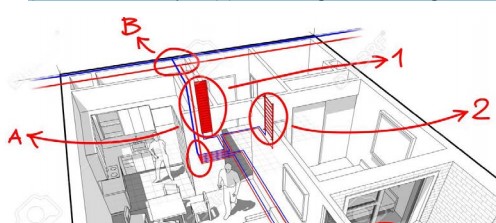 Designing Isn’t Just for the Fashion Industry
Designing Isn’t Just for the Fashion Industry
The design of your heating and cooling systems is just as important as the design of your favorite clothing. Without a proper eye for HVAC design, your heating and cooling equipment wouldn’t fit quite right, and wouldn’t be as efficient as it could be.
What sort of factors are there to consider when designing HVAC systems?
Well, there’s equipment sizing, ductwork installation, ventilation, design protocols and code compliance to name a few.
HVAC System Types
Before you design your system, it’s essential to learn the different types of HVAC systems and each unit’s benefits. HVAC types include:
Traditional Split Systems
A traditional split system has two units — one for cooling and one for heating.
Most buildings with split systems have a gas furnace installed in the basement and an air conditioning unit installed outside. The air conditioner uses compressors, coils and coolant to cool air and a fan to push out hot air. The furnace blows out hot air with a fan or evaporator. Thermostats control both systems, allowing you to set your desired temperature. Ducts carry your heated or cooled air throughout the building.
Traditional split systems are popular options for residential use.
Ductless Split Systems
A ductless system is an alternative solution for spaces incompatible with traditional duct systems. Instead of using a furnace or standard air conditioner, a ductless system has individual units. Professionals install these units directly into the walls or ceilings of the rooms that need heating and cooling.
You can control each unit with its own thermostat, making a ductless split system an excellent choice for buildings with separate units, such as apartment complexes and hotels.
Hybrid Split System
A hybrid split system uses an electric-powered heat pump and a furnace. You can choose between the two units to decide how you want to heat your home in winter, giving you more control over your energy costs. In summer, the heat pump acts as an air conditioner by pulling heat out of your home.
A hybrid system uses traditional ducts and thermostats, operating similarly to a traditional split system.
Packaged Systems
A packaged system contains all significant heating and cooling components in one unit. The system’s compact nature makes it a good fit for small spaces that can’t accommodate all the separate parts of split systems. Professionals install these units outdoors and use a blower to draw air into and out of the system.
Geothermal Systems
Geothermal HVAC systems use the earth to facilitate heating and cooling. In this system, an electric pump moves fluid through underground pipes. During winter, the warm temperatures of the rock, soil and water heat the fluid, and a heat exchanger transfers the fluid’s warmth to heat your air. In summer, the fluid absorbs the heat in the air and disperses it into the ground.
This naturally aided process makes geothermal systems up to four times more energy-efficient than traditional systems.
Learn More About Our HVAC Services
What Are the Most Common HVAC Systems?
The most common types of HVAC units are traditional split systems and hybrid split systems. Traditional split systems are the most versatile, cost-effective type of HVAC system. You can use these units almost anywhere without meeting specific environmental requirements and install new components with little to no modifications to your existing ductwork.
Hybrid systems are popular because they operate similarly to traditional systems, with the added benefit of having two forms of heat to choose from. This choice allows you to determine the best form of heat to use based on your energy costs.
Sizing
The sizing of your equipment is more important than you may realize, and it isn’t as simple as “bigger is better” either. When a furnace is too large for a space, it heats up quickly – which isn’t as good as it sounds. As a result, the equipment cycles more frequently (turning off when it reaches a set temperature) which causes greater wear and tear. When a furnace is too small for a space, it runs indefinitely, desperately trying to warm the rooms in your home to the desired temperature but never reaching it. This means more fuel is used, costing you more in the long run!
How should you make decisions about heating system design? The Air Conditioning Contractors of America (ACCA) published a book called “Manual J” that includes guidance on load calculations. They based this guidance on the best information available around heating system installation, and it takes into account new technology, too. When it comes to heating system design and load calculations, you’ll want a large knowledge base of the industry’s facts and figures, and you’ll find it in “Manual J.” Don’t risk having your installers put in a system that’s too big or small. Get it just right with load calculations made by experts.
Ductwork
The ductwork of your HVAC system is the key to even comfort throughout your home. Duct sizing needs to be appropriate for the space to avoid loss of air temperature as conditioned air travels along the ductwork. Additionally, the length and specific path the air travels will play a large part in airflow. Ductwork with tight turns, odd angles and long runs can impede the level of comfort you’re feeling in your home.
Just as the ACCA provides “Manual J” that includes load calculations, the ACCA also provides what’s called “Manual D” — a book that outlines how to design duct systems for any given heating system. You’ll want your heating system and its ducts to be proportional and complementary. If you mismatch your heating system and its ducts, you’re going to have issues over the long-term.
Ventilation
Ventilation is pivotal to your home comfort – and your health! Without proper ventilation, you can experience poor indoor air quality, and that leads to health issues ranging from difficulty sleeping to allergy flare-ups or asthma attacks.
Most home and business owners don’t realize just how important ventilation is to prevent mold and moisture in the home. Mold and moisture are both dangerous and costly to eradicate, which means prevention is the best approach to dealing with them. Make sure your installers know how to properly ventilate your home and its heating system, so you avoid mold and moisture.
Design Protocols
There’s no reason for your installers to reinvent the wheel when it comes to heating system design. The ACCA’s manuals help provide a large knowledge base of industry data and best practices that heating system installers can use. These design protocols are proven, and you can follow them to deliver the best possible results. If you have any doubts about your installers or their heating system design, ask about their design protocols and whether or not they are following ACCA’s best practices.
Code Compliance
All local, state and federal areas are governed by building codes. Your heating system design will need to adhere to the codes of the various regulatory bodies that govern your area. If your installers fail to create a heating system that follows code, you may face fines or have issues when it’s time to resell your home. Neither is an ideal situation for a homeowner.
Why Choose Leggett Inc. as Your Installer?
Since 1966, Leggett Inc. has been family-owned, family-operated and proudly serving home and business owners throughout Central Pennsylvania. We provide a range of solutions, heating system design included, and our technicians are adept at installation, repair and maintenance of heating and cooling systems, electrical systems, home plumbing, water heaters, thermostats and controls, plus more. We can provide factory-authorized service on systems made by Trane, Amana, Goodman, Carrier, Generac, Eaton, Honeywell, Rheem, ISE, Moen and Kohler, and our work is backed by a 24-month guarantee.
Get a Free Quote or Schedule an Appointment
Hopefully now you have a better understanding of the amount of work that goes into properly designing and installing an HVAC system in your home! If you have any further questions about how well your equipment is running, don’t hesitate to give us a call!




